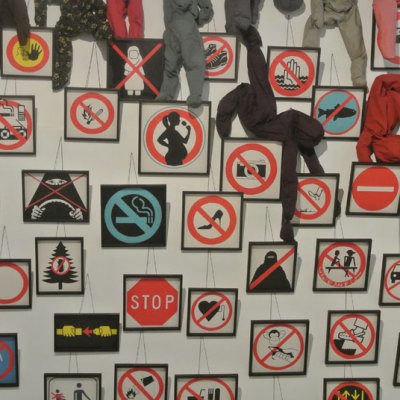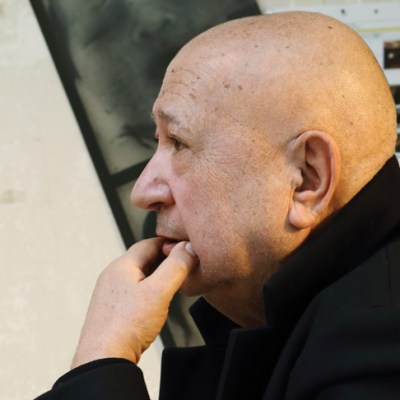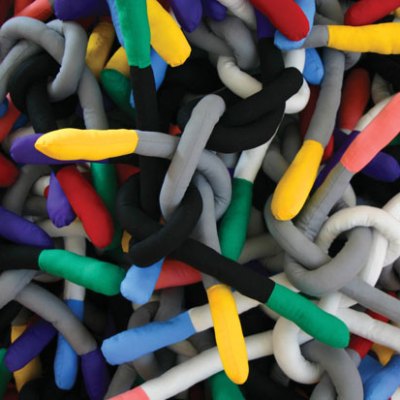From the September 2022 issue of Apollo. Preview and subscribe here.
In Annette Messager’s front room, up on its hind legs on a raised wooden platform usually reserved for plants, is a taxidermy rabbit with a machine gun slung around its little furry body. ‘Revenge against the hunter,’ the artist says with a faint smile. I am visiting her on a Saturday morning at her home and studio in Malakoff, the suburb of Paris where she has lived since the early 1980s. It is in the middle of one of the summer heatwaves and when Messager opens the door to me she looks horrified – I am wearing a light jumper. I defend myself, explaining that I will be going to the cinema later. I note as I go inside that she is wearing a dark-blue shirt covered in different phases of the moon.
As we talk, the moons distract me. So does the rabbit, and also a cat with its back to me gazing out on to the vast and beautiful garden, thick with large plants. I think it is alive and Messager sees me looking at it. ‘He was just like that,’ she says sadly. Another stuffed animal then. There are so many of these in Messager’s home and in her art. Her cat died not long ago, she tells me, so she created a fluffy version now permanently perched look- ing out the window. The feline homage reminds me of her friend and next-door neighbour Sophie Calle, who devoted a whole show to her own cat, Souris, when the animal passed away in 2018.
If I look around Messager’s front room I risk losing my concentration; the space is full of clues about her art. It also contains works by other artists. Directly behind her head at the table where we are sitting are two paintings by the outsider artists Aloïse Corbaz and Augustin Lesage. Art Brut has been something of a lifelong interest, dating back to her childhood growing up in Berck-sur-mer, in the Pas-de-Calais region of northern France. The vast Berck beaches were surrounded by hospitals and decaying German blockhouses. On the sandy shores she found debris from the Second World War and was struck by all the sick people who walked around. There was craftsmanship at home; her mother was a seamstress. But it was her father, an architect, who piqued her early interest in art. He liked to paint and in the early mornings would bring her croissants and she would listen to him talk about his work. Jean Dubuffet, who coined the term Art Brut, was also a family friend and local. Seeing the works he collected – strange and wonderful creations made from found material by people who did not call themselves artists or seek to exhibit – was, for young Messager, a door opening to a world not restricted to a set of aesthetic principles or under the sole influence of the Old Masters.
Installation view of Daily (2015–16) Annette Messager. Photo: Atelier Annette Messager; courtesy Marian Goodman Gallery; © Adagp, Paris

Although, its use of ordinary materials to extraordinary ends gives Messager’s work something in common with Art Brut, it is so exquisitely put together that you can’t but see the deft hand of a master craftswoman and a fine draughtswoman. There is, however, plenty of trauma in her own work. It is often political; it can also be personal, as with the references to her recent breast cancer that we find in some of the installations included in two exhibitions this year. ‘Comme Si’ (As if ) ran at the Lille métropole musée d’art moderne (LaM) from May to August and will travel to an as-yet-unannounced European museum in 2023, while ‘Desires, Disorders’ is a retrospective at the Tel Aviv Museum of Art (until 3 September).
We are meeting shortly after Messager’s cataract operation. She had the surgery filmed, thinking she might use the footage in some way in her art. Her partner, the late Christian Boltanski (see April 2018 issue of Apollo), also had a video recording from when he had undergone the same operation and she is still pondering what to do with the material, but the very act of having a video camera in the operating room for a routine procedure is typical of Messager. She is adept at making strange the familiar and, in doing so, invites us to see the banal in a new light.
Indeed, after I see her exhibitions in Tel Aviv and Lille, I find it hard to see sleeping bags, cuddly toys, shoes or colouring pencils in the same way. Ordinary objects can be the full focus of a piece, such as a map of France in ‘Comme Si’, made entirely of dismembered stuffed toys, or the contents of a vanity case that opens the show in Lille. The vanity-case items include scissors, needles and a mobile phone, but they are enormous, hanging from the ceiling, made from a sleek black synthetic leather and sewn together perfectly. Rats made from black wrap tape and painted again in black matt paint are, however, on the ground below, a pointed reminder that the gutter is never far away. Rodents feature in many of Messager’s installations and we find several, along with her beloved snails, scattered around sections of the Lille show: in the corners of rooms, hanging on the wall or sitting on win- dow ledges and shelves, all made from scrunched thick paper like papier mâché and painted black.
Messager assembles all these items in her studio in Malakoff, with the help of two assistants. The large space where she works is next to her home, accessible via the back gate, and then down a short tunnel that, on the day I visit, is lined with piles of old stuffed animals – many missing a limb or a chunk of their face, others completely decapitated. One teddy bear that catches my eye is missing a nose, which has been replaced with black masking tape. ‘Well, if you can’t even do that to a stuffed toy…’ Messager says, dismissing my mild alarm. This distorted sense of the familiar is what gives Messager’s work a menacing air laced with humour. The dual quality is well summarised by the introductory wall of the Lille exhibition where, across a large white space visible to all the museum’s visitors, the two words comédie and tragédie intersect at the ‘g’ and ‘m’, sharing the last four letters. The lettering is made from iron piping, netting, stuffed toys and cloth. For Messager this captures not only art but also life, which is always experienced as a mixture of joy and sadness, sickness and health, solitude and companionship. And so we go through life acting ‘as if’ things were less awful, ‘as if’ we were experts rather than novices, ‘as if’ the worst is not going to happen. ‘Think about how many times you say “as if” in a day,’ Messager says, explaining the title of the Lille show, for which she has also, in a first, recorded her voice repeating the two words that can be heard on loudspeaker at various points.
Annette Messager photographed at her studio in Collection Name Paris in August 2022

On the wall of her living room is a series of framed black-and-white photographs showing different women, all blurry and mysterious; the subjects never looking at the camera but instead unaware a lens is even on them. Messager says that she was fascinated by the voyeurism that drives this work by Miroslav Tichý, a Czech painter who had never considered the photos art, but took thousands secretly using a camera made from cardboard tubes, tin cans and other materials. This all reminds me of the camera glasses Chris Marker used in the Paris metro to take photos of passengers, which would get him into a great deal of trouble today. The idea of stolen photographs is also reminiscent of Les Approches (1972), a series of photographs that Messager took in the streets of Paris. Nobody complained about photographs of women’s breasts, so she decided to do the same and look only at male crotches. Messager talks about the work as though it were an obvious thing to do. She is not an artist who is overtly political or has a message she wants to ram home. Rather, politics enters her work as a form of provocation, as she seeks to make us question our assumptions about what we see and what we say every day. Early in her career she was labelled a feminist but she has never identified as such. Nevertheless her work does revolve to a great extent around gender issues and the way in which the female body in particular is represented and often exploited or erased and appropriated by the male gaze.
Wistfully Messager shows me some tote bags she had made for the Lille show. I immediately recognise one of her watercolours of a uterus (this one has a smiley face). There is a whole room at the LaM, named ‘Black Continent’ (not to be confused with Black Continents, a multi-work installation of 2010–12), which is covered in a wallpaper of Messager’s watercolours of uteruses, all quirkily different or suggestively twisted. Looking at the tote bags, Messager shakes her head. ‘It will be complicated to bring this out now,’ she says. It is the same week that the US Supreme Court has ruled to overturn Roe vs Wade, opening the way for states to set their own laws on abortion and allowing some to ban it almost completely. I suggest it is a perfect time for such a bag, but she shrugs. Changing people’s minds about an issue is not why she goes to her studio every day.
Messager’s attitude may seem cold but, despite its often dark subject matter, her art has a striking warmth. This is in part because it invites us in for contemplation, rather than pushing us away with its abstraction. There is also a tactile quality to the work, from Messager’s manipulating much of the material with her own hands. The texture of her pieces is always integral to their effect, from the blackwrap rats that are somehow satisfying in their thick matt solidity, to the softness of the dismembered toys making up her map of France. They seem soft and alluring at first, but when we approach we see they are not very clean, giving them, and the work overall, a distinctly seedy air. In so many of her pieces, stitching and sewing are often a feature – done perfectly, or badly on purpose to create splits and tears that evoke injury or some other kind of trouble (in this it has something in common with the art of Louise Bourgeois).
Installation view of Faire des cartes de France (Making maps of France), 2000, Annette Messager. Photo: Philip Bernard; © Adagp, Paris

As the curator of the Lille exhibition, Marie-Amélie Sénot, tells me on my visit, it is an essential element of Messenger’s work and she is very exacting about each detail. Indeed, one of Messager’s most striking yet simple pieces is included, in slightly different versions dating from 2014 and 2015, in both exhibitions. Tribute to Seamstresses is made of seven three-metre-long yellow measuring tapes draped across a white wall, hung carefully on a set of nails forming what looks like a large, elegant cape, intended to evoke the garb of a superhero. It asks us to pay our respects to the petites mains (‘little hands’) of the fashion industry, who are never visible, eclipsed by the glamour of models and designers.
Another stand-out piece, appearing in slightly different forms in both Lille and Tel Aviv, is the installation Casino, for which Messager won the Golden Lion at the Venice Biennale in 2005. In Tel Aviv it fills a whole room and visitors can observe the installation only from outside, peering through windows giving on to the room. In Lille the modified version is called Dessus-dessous (‘Upside Down’; 2019). Here on a small strip of floor we are able to walk around the undulating red silk fabric at the centre of the work. As we do so, we catch glimpses underneath the material revealing items from what could be the contents of an opened suitcase, or from a shipwreck: clothes, shoes, books and toiletries are scattered around. Mingled among the objects are what look like human limbs. ‘The red fabric is blood and the Mediterranean is full of corpses,’ Messager says, referring to the desperate, often deadly, boat crossings undertaken by migrants every day.
Sound is a crucial element in this work, as it often is with Messager’s installations. At her shows there is nearly always the noise of a ventilator circulating air to keep items blowing about and creating the feeling that the work is alive. The effect is animated, but also creepy: like a puppet lying on the ground that suddenly jumps to life. In Dessus-dessous, Messager lays greater than usual emphasis on sound, with the drone of the ventilator mixed with distant gusts of blowing air that evoke the crashing of ocean waves and the wind whipping up, then dying down. The marine setting and billowing silk could all be very peaceful but the atmosphere of the work is quite the opposite. It is clear we are in a place not of rest but of torment. When we glimpse the forms beneath the silk it is like flashes in a horror film.
Sleeping Songs (2018–19) is another work Messager created in response to the migrant crisis after a visit to Calais when the camp known as ‘The Jungle’ was still running; it has since been razed by order from the French government. She was struck by how the people she met were making the best they could out of the nothing they had, and how these camps were made homely, though they were such inhospitable places. Sleeping Songs, on display in Tel Aviv, comprises three sleeping bags hang- ing on the wall, all with human shapes suggested inside – bumps that could be a torso or a knee – and with limbs emerging: a gloved set of hands in one, shoes poking out of another. The hands are sinister, but they are also vulnerable; their gesture is tentative, not aggressive. Few artists have Messager’s ability to capture the human costs and emotions at play in a particular tragedy or everyday experience, and to do so without grandstanding.
As we are talking, the door buzzer goes off and Messager gets up to answer it, but shoots an anxious look at me before disappearing into another room. A few seconds later she returns with her mobile phone. A new intercom system has recently been installed and ‘It’s very complicated,’ she says. Indeed, I confirm it took me a good five minutes to work out how to call her apartment when I arrived, and I regretted the simple door code for entry that you usually find in Paris. ‘Why do things simply when you can be complicated?’ she asks, deadpan. Nothing could be further from her own approach.
From the September 2022 issue of Apollo. Preview and subscribe here.



